
Deposition Date
2009-06-19
Release Date
2014-07-09
Last Version Date
2023-09-20
Entry Detail
PDB ID:
4V6B
Keywords:
Title:
Crystal structure of human ferritin Phe167SerfsX26 mutant.
Biological Source:
Source Organism:
Homo sapiens (Taxon ID: 9606)
Host Organism:
Method Details:
Experimental Method:
Resolution:
2.85 Å
R-Value Free:
0.29
R-Value Work:
0.24
Space Group:
P 1


